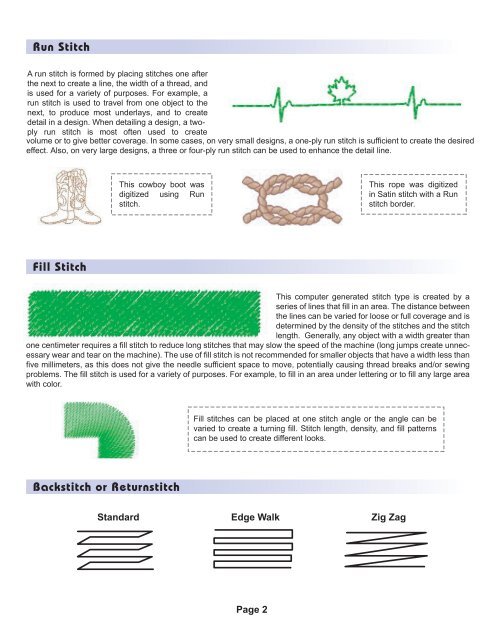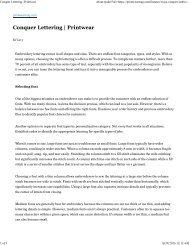Embroidery Basics Articles
You also want an ePaper? Increase the reach of your titles
YUMPU automatically turns print PDFs into web optimized ePapers that Google loves.
Run Stitch<br />
A run stitch is formed by placing stitches one after<br />
the next to create a line, the width of a thread, and<br />
is used for a variety of purposes. For example, a<br />
run stitch is used to travel from one object to the<br />
next, to produce most underlays, and to create<br />
detail in a design. When detailing a design, a twoply<br />
run stitch is most often used to create<br />
volume or to give better coverage. In some cases, on very small designs, a one-ply run stitch is sufficient to create the desired<br />
effect. Also, on very large designs, a three or four-ply run stitch can be used to enhance the detail line.<br />
This cowboy boot was<br />
digitized using Run<br />
stitch.<br />
This rope was digitized<br />
in Satin stitch with a Run<br />
stitch border.<br />
Fill Stitch<br />
This computer generated stitch type is created by a<br />
series of lines that fill in an area. The distance between<br />
the lines can be varied for loose or full coverage and is<br />
determined by the density of the stitches and the stitch<br />
length. Generally, any object with a width greater than<br />
one centimeter requires a fill stitch to reduce long stitches that may slow the speed of the machine (long jumps create unnecessary<br />
wear and tear on the machine). The use of fill stitch is not recommended for smaller objects that have a width less than<br />
five millimeters, as this does not give the needle sufficient space to move, potentially causing thread breaks and/or sewing<br />
problems. The fill stitch is used for a variety of purposes. For example, to fill in an area under lettering or to fill any large area<br />
with color.<br />
Fill stitches can be placed at one stitch angle or the angle can be<br />
varied to create a turning fill. Stitch length, density, and fill patterns<br />
can be used to create different looks.<br />
Backstitch or Returnstitch<br />
Standard Edge Walk Zig Zag<br />
Page 2




